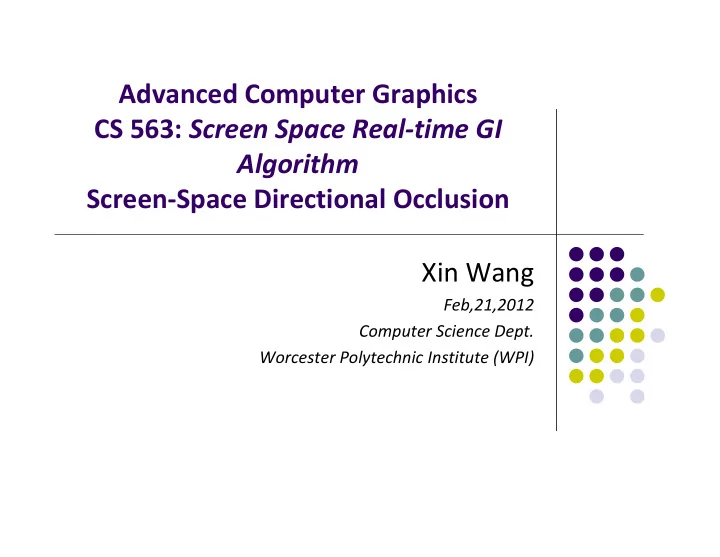

Advanced Computer Graphics CS 563: Screen Space Real ‐ time GI Algorithm Screen ‐ Space Directional Occlusion Xin Wang Feb,21,2012 Computer Science Dept. Worcester Polytechnic Institute (WPI)
Overview Real ‐ time Global Illumination Approximation Computed in image space Extension of Ambient Occlusion Small ‐ scale geometry Independent of scene complexity Directional Occlusion Indirect Bounces Complements classic illumination
Ambient Occlusion (AO) Global illumination Coarse approximation Efficient (e.g. real ‐ time) Plausible results Perceptually important [Langer and Bülthoff 1999] Idea: Compute average visibility Multiply with unoccluded illumination at run ‐ time Can be precomputed (vertex / texel)
Previous Work Ambient illumination model [Zhukov et al. 1998] Production rendering [Landis 2002] Moving rigid objects [Kontkanen et al. 2005, Malmer et al. 2007] Approximate color bleeding [Mendez et al. 2006] Point ‐ based occlusion/indirections [Christensen 2008] Screen ‐ Space [Mittring 2007, Shanmugam and Arikan 2007, Bavoil et al. 2008, Filion et al. 2008]
Screen ‐ Space Ambient Occlusion SSAO Used in current games Ambient Occlusion for each framebuffer pixel No precomputation Dynamic scenes Simple implementation Independent of scene complexity, real ‐ time on recent GPUs
Ambient Occlusion Review Directionally ‐ varying light is ignored Example: Shadow at point P should be green because only the red light is occluded AO computes unoccluded illumination first (=yellow) and scales by a single occlusion P value (=0.4) shadow at P is brown
Ideal Approach Traditional SSAO [Shanmugam and Arikan 2007] Observation: If loop though a number of samples for each pixel, why not * just integrating the incoming P P radiance for each direction ? Multiply by unoccluded illumination Screen ‐ Space Directional Occlusion (SSDO) Approximate visibility for each sample Accumulate only visible illumination P
SSDO Visibility For each pixel in framebuffer Env.map Compute N samples (A – D) in the upper hemisphere of P with user ‐ defined radius rmax For each sample Backproject sample to image Compute position on surface from z ‐ Buffer If the sample point goes up, it is C treated as occluded (A,B,D) A If the sample goes down, P is D n B illuminated from this direction (C) P (blurred envmap, filter ) 2 / N r max
Equations SSDO is a improvement of SSAO Irradiance of each fragment N L P L V ( ) ( ) ( ) cos dir in i i i i 1 Indirect Bounces N A cos cos s si ri L P L V ( ) ( 1 ( ) ) ind pixel i 2 d i 1 i
Directional Occlusion SSDO shadows Oriented Colored SSAO shadows Not oriented Grey Similar computations SSDO overhead: 3.6%
Indirect Illumination Env.map Each sample is a small area light Oriented around pixel normal Radiance = direct light For each sample Compute form factor to P and accumulate contributions Results in one indirect bounce of light for nearby geometry P r max
Indirect Illumination Direct light using e.g. Environment map (Sky) Point light with shadow map (Sun) Temporal coherence Overhead: ~30%
Comparison with PBRT
Speed ‐ up: Interleaved Sampling Reduce the computation for each pixel [Keller and Heidrich 2001, Segovia et al. 2006] Not all N samples are used Instead: Use blocks of MxM pixels Each pixel uses only N/(MxM) samples Apply geometry ‐ aware blur [Laine et al. 2007]
Exmple Scene GeForce 8800 GTX Resolution: 1024 x 768 Polys: ~300k SSDO: 55 – 80 fps Bounce: 40 – 65 fps 3D Model from Dosch Design
Non ‐ polygonal Scenes and Animations GeForce 8800 GTX Resolution: 1024 x 768 Volume: 256^3 Volume Data from UTCT
Limitation I Env.map Visibility is an approximation Only nearby geometry: No occluders outside sphere Wrong classification Sample A: z 1 treated as an occluder Sample B: B A treated as visible n P r max
Solutions Env.map Sample A: Depth Peeling [Lischinski et al. 1998, Everitt 2001] Sample B: z Use multiple samples on a line 1 z 2 B A n P r max
Limitations II Only visible senders can contribute to indirect illumination Especially grazing angles Fade in/out of indirect light Fortunately no abrupt changes visible Solution: Use multiple cameras
Solution – Multiple Cameras Color Bleeding from senders viewed from a grazing angle Four cameras Placed manually Lower resolution Overhead: 50% ‐ 160% 1x fill ‐ rate 4x transform ‐ rate
Extend Object ‐ based Techniques Idea: Add SSDO on top of existing Global Illumination techniques Example: Shadow Mapping, 218 fps Shadow Mapping l Typical problem: b p Details and contact shadows P are lost due to the depth bias Can be corrected in image space ( max r b )
Extend Object ‐ based Techniques Idea: Add SSDO on top of existing Global Illumination techniques Example: Shadow Mapping, 218 fps Shadow Mapping Typical problem: Details and contact shadows are lost due to the depth bias Can be corrected in image space r max correction, Peeled correction, 103 fps two depth layers, 73 fps
Application: Natural Illumination
Overall Summary SSDO: Screen ‐ Space Directional Occlusion Approximation of Global Illumination in image space Correctly oriented, colored shadows One bounce of indirect light possible Interactive to real ‐ time frame rates, independent of scene complexity
References Approximating Dynamic Global Illumination in Image Space. Thorsten Grosch, ACM I3D ’09, Boston, MA http://www.cnblogs.com/atyuwen/archive/2010/03/ 31/ssdo.html
Recommend
More recommend